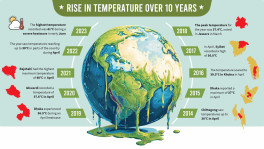The market is finally putting a realistic price on carbon
This surge should be seen as a success. Politicians need to resist the populist impulse to intervene and drag down prices

What's clean, invisible, and has notched up a better investment performance than Bitcoin and (briefly) GameStop Corp. stock over the past 12 months?
European carbon credits. The instruments are auctioned to major polluters in the European Union and exchanged in the bloc's Emissions Trading System, or ETS, to encourage them to price and reduce their emissions. They've risen about 131% in a year, hitting an intraday record of 98.49 euros ($112) a metric ton Tuesday.
Those levels are extraordinary by the standards of the recent past — but they're also troubling. On paper, such numbers should be a game-changer for decarbonisation technologies. In practice, we've yet to see the transformation that the world needs.
Current prices are nearly triple the $40 that economist William Nordhaus cited as an optimal cost of carbon in his speech accepting the 2018 Nobel Prize for economics. Carbon capture and storage, or CCS, a process that separates out CO2 from flue gases and pipes them into underground rock formations, should cost from around $62 to $125 a ton, based on a study last year by the International Energy Agency.
The price may go higher still. Lawson Steele, a carbon and utilities analyst at Berenberg, expects to see a peak of 150 euros a ton during the first three quarters of this year. Oil hedge fund manager Pierre Andurand and green finance analyst Mark Lewis are on the same page, arguing last month that a price of 90 euros to 150 euros is needed to encourage the continent's major emitting sectors to decarbonise.
Yet despite a surge in renewable power generation in Europe over the past decade, many of the industries that ought to be emerging to take advantage of this drastic shift in costs remain in their infancy.

Take carbon capture, a mature technology that's already used extensively to drive extra crude out of oil fields. It failed to play its promised part in cutting power-sector emissions largely because adding it onto the base price of coal- or gas-fired power produces electricity that can't compete with renewables on cost.
The soaring price of carbon, however, along with the need for a flexible generation technology to cover gaps in wind and solar, should provide exactly the revenue model it needs. Utilities that can provide power on-demand while paying $100 to capture and store a ton of carbon should prefer that to paying $150 for an emissions permit.
At Groningen in the northern Netherlands, you can see the consequences of the policy failure. One of the largest gas fields in history is being closed down this year, just as soaring carbon prices might give it a new lease on life as a place to bury emissions.
"If CCS does not succeed in the Netherlands," a group of Dutch academics led by Sanne Akerboom argued in a study last year, "it is hard to imagine where it would have a better chance."
One explanation for the failure of investment to turn up is that engineering moves in years, while markets move in minutes. Major industrial plants using breakthrough technologies take the best part of a decade from conception to completion, but EU carbon went sustainably north of 30 euros a ton only last year. If that's the case, expect to see a run of green project announcements in coming years that will dwarf what's been seen so far.
Another possibility is that emitters are betting they can simply pass costs on to consumers, and ultimately to governments. That's essentially what's happening in the UK, where the rising price of gas has hit households and resulted in a $12 billion government support package to avert a cost-of-living crisis. That would defeat the entire purpose of the ETS, which is to ensure that polluters pay, and change their behaviour accordingly.
A more benign explanation is that major emitters are betting the shift in carbon prices is a blip — a hunch endorsed by their 6.3% slump Wednesday after a key European legislator told reporters the system would need to be tweaked to prevent price spikes.
With issuance of the permits set to decline by law at a rate of 2.2% a year (and 4.2% a year from 2024), it's hard to see how the market fails to remain in deficit, a factor that should be bullish for prices. Power-sector emissions in Europe are, if anything, likely to rise over the next few years as nuclear plants are switched off faster than renewable generators are installed to replace them. Still, a price floor — like those introduced in Sweden and the UK and proposed by Germany's new government — might help convince industry that spending on decarbonisation won't be undermined by a future slump in the carbon market.
The current surge in carbon should be seen as a success, finally bringing the cost of emissions in Europe to a level sufficient to switch to less polluting technologies. Politicians should give it the chance to do its work and resist the populist urge to drag down prices. The surest route to failure would be hasty intervention.
David Fickling is a Bloomberg Opinion columnist covering commodities, as well as industrial and consumer companies. He has been a reporter for Bloomberg News, Dow Jones, the Wall Street Journal, the Financial Times and the Guardian.
Disclaimer: This article first appeared on Bloomberg, and is published by special syndication arrangement


 Keep updated, follow The Business Standard's Google news channel
Keep updated, follow The Business Standard's Google news channel















